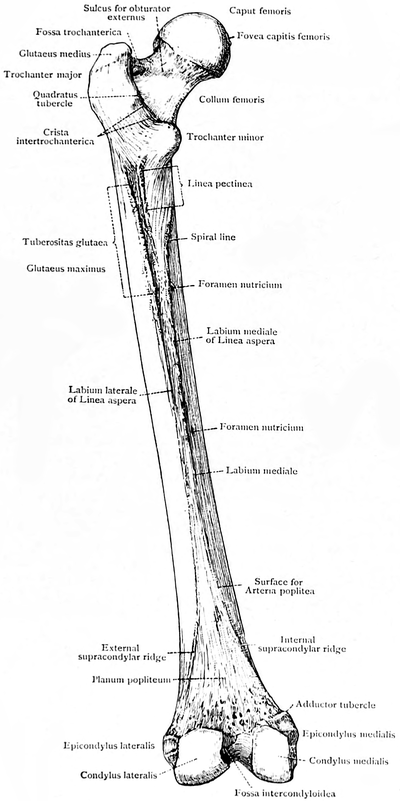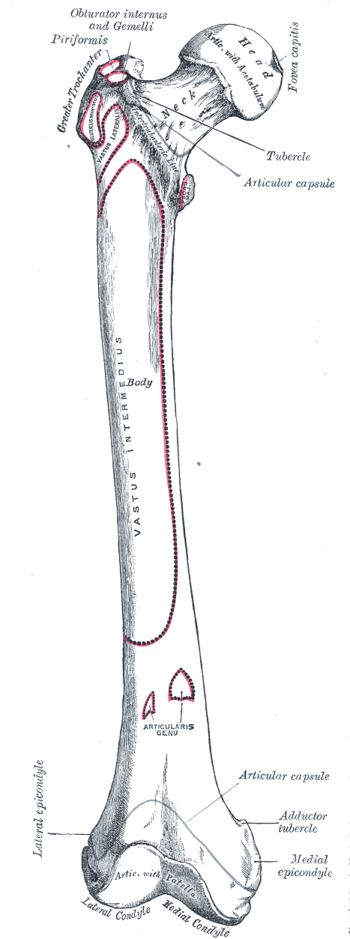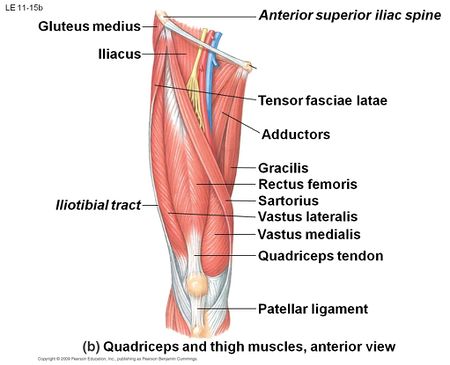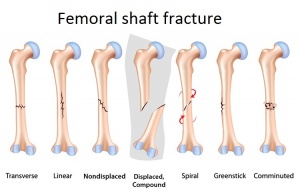Femur: Difference between revisions
No edit summary |
No edit summary |
||
| Line 10: | Line 10: | ||
* The upper body’s weight sits on the 2 femoral heads. The capsular [[ligament]] is a strong thick sheath that wraps around the acetabulum periosteum and proximal femur holding the femoral head within the acetabulum. | * The upper body’s weight sits on the 2 femoral heads. The capsular [[ligament]] is a strong thick sheath that wraps around the acetabulum periosteum and proximal femur holding the femoral head within the acetabulum. | ||
* Robust shape of the femur provides many sturdy attachment points for the powerful muscles of the hip and knee that contribute to walking and other propulsive movements.<ref name="Moore">Moore KL, Agur AM, Dalley AF. Essential Clinical Anatomy. 4th ed. Baltimore, MD: Lippincott Williams and Wilkins, 2011.</ref> | * Robust shape of the femur provides many sturdy attachment points for the powerful muscles of the hip and knee that contribute to walking and other propulsive movements.<ref name="Moore">Moore KL, Agur AM, Dalley AF. Essential Clinical Anatomy. 4th ed. Baltimore, MD: Lippincott Williams and Wilkins, 2011.</ref> | ||
== | == Femur: Three Divisions == | ||
The femur acts as the site of origin and attachment of many muscles and ligaments, and can be divided into three parts; proximal, shaft and distal. <ref name=":0">Chang A, Breeland G, Hubbard JB. [https://www.ncbi.nlm.nih.gov/books/NBK532982/ Anatomy, Bony Pelvis and Lower Limb, Femur.] InStatPearls [Internet] 2019 Jul 3. StatPearls Publishing.Available from:https://www.ncbi.nlm.nih.gov/books/NBK532982/ (last accessed 16.6.2020)</ref> | |||
'''Proximal Femur''' | '''Proximal Femur''' | ||
At the proximal end of the femur, the bulbous femoral head is joined to the shaft of the femur by the femoral neck. At the base of the neck are the medially oriented lesser trochanter and laterally placed greater trochanter. A rough line called the intertrochanteric line connects the greater and lesser trochanter on the anterior aspect of the femur, while the smoother intertrochanteric crest connects the trochanters posteriorly.<ref name="Moore" /> | At the proximal end of the femur, the bulbous femoral head is joined to the shaft of the femur by the femoral neck. At the base of the neck are the medially oriented lesser trochanter and laterally placed greater trochanter. A rough line called the intertrochanteric line connects the greater and lesser trochanter on the anterior aspect of the femur, while the smoother intertrochanteric crest connects the trochanters posteriorly.<ref name="Moore" /> | ||
[[File:Femur Angles of Inclination.jpg|thumb|Angles of Inclination ]] | |||
[[ | Angle of Inclination: The angle between the femoral neck and the medial side of the femoral shaft viewed from the frontal. Greater at birth but decreases during childhood and adolescent development due to loading stresses across the femoral neck in weight-bearing and walking. Normal angle of inclination of 125 degrees increases mobility of the femur at the hip joint by placing the femoral head and neck in a biomechanically favourable position for walking. Abnormal angles -coxa vara less than 125 degrees; coxa valga greater than 125 degrees. Both alter hip biomechanics, leading to malalignment and complications.<ref name="Moore" /><ref name="Neumann" /> | ||
'''Femoral Shaft''' | '''Femoral Shaft''' | ||
[[File:Femur front.png|right|frameless|939x939px]] | [[File:Femur front.png|right|frameless|939x939px]] | ||
The shaft of the femur courses on an oblique lateral to medial angle, functioning to bring the alignment of the knees and feet closer to midline.<ref name="Neumann" /> | The shaft of the femur courses on an oblique lateral to medial angle, functioning to bring the alignment of the knees and feet closer to midline.<ref name="Neumann" /> A cross section of the shaft in the middle is circular but flattened posteriorly at the proximal and distal aspects. | ||
A cross section of the shaft in the middle is circular but flattened posteriorly at the proximal and distal aspects. | |||
* Posterior surface shaft - roughened ridges of bone, called the linea aspera (Latin for rough line). These split inferiorly to form the medial and lateral supracondylar lines. The flat popliteal surface lies between them. | * Posterior surface shaft - roughened ridges of bone, called the linea aspera (Latin for rough line). These split inferiorly to form the medial and lateral supracondylar lines. The flat popliteal surface lies between them. | ||
* Proximally - medial border of the linea aspera becomes the pectineal line. The lateral border becomes the gluteal tuberosity, where the gluteus maximus attaches. | * Proximally - medial border of the linea aspera becomes the pectineal line. The lateral border becomes the gluteal tuberosity, where the gluteus maximus attaches. | ||
| Line 50: | Line 45: | ||
== Articulations == | == Articulations == | ||
# The femoral head of the proximal femur articulates with the acetabulum of the pelvis in which the femoral head acts at the ball and the acetabulum as the socket. Allows for movement at the [[Hip|hip]] in three [[Cardinal Planes and Axes of Movement|planes]]: flexion and extension in the sagittal plane, abduction and adduction in the frontal plane, and internal and external rotation in the horizontal plane.<ref name="Neumann">Neumann DA, Kinesiology of the musculoskeletal system: Foundations for rehabilitation. 2nd ed. St. Louis, MO: Mosby Elsevier, 2010. p520-71.</ref> | # The femoral head of the proximal femur articulates with the acetabulum of the pelvis in which the femoral head acts at the ball and the acetabulum as the socket. Allows for movement at the [[Hip|hip]] in three [[Cardinal Planes and Axes of Movement|planes]]: flexion and extension in the sagittal plane, abduction and adduction in the frontal plane, and internal and external rotation in the horizontal plane.<ref name="Neumann">Neumann DA, Kinesiology of the musculoskeletal system: Foundations for rehabilitation. 2nd ed. St. Louis, MO: Mosby Elsevier, 2010. p520-71.</ref> | ||
# Distally, the convex femoral condyles of the femur articulate with the condyles of the [[Tibia|tibia]], ie [[Knee|tibiofemoral joint]]. Movement at the tibiofemoral joint occurs in two planes: knee flexion and extension in the sagittal plane, and internal and external rotation in the horizontal plane.<ref name="Neumann" / | # Distally, the convex femoral condyles of the femur articulate with the condyles of the [[Tibia|tibia]], ie [[Knee|tibiofemoral joint]]. Movement at the tibiofemoral joint occurs in two planes: knee flexion and extension in the sagittal plane, and internal and external rotation in the horizontal plane.<ref name="Neumann" /> | ||
# The patellofemoral joint is formed by the articulation of the [[ | # The patellofemoral joint is formed by the articulation of the [[patella]] with the intercondylar/trochlear groove of the femur. During flexion and extension of the knee, the articular surfaces of the patella and femur perform a sliding movement.<ref name="Neumann" /> | ||
== Injuries and Conditions == | == Injuries and Conditions == | ||
| Line 63: | Line 58: | ||
PMID: 25804713</ref> | PMID: 25804713</ref> | ||
Neck of femur fracture | |||
Trochanteric syndrome | |||
Trochanteric bursitis | |||
<br> | <br> | ||
Revision as of 09:49, 12 December 2022
Original Editor - Daphne Jackson
Top Contributors - Lucinda hampton, Kim Jackson, Evan Thomas, Admin, Daphne Jackson, Joanne Garvey, Joao Costa and WikiSysop
Introduction[edit | edit source]
The femur is the longest, heaviest, and strongest bone in the human body.
- The main function of the femur is weight bearing and stability of gait. An essential component of the lower kinetic chain.
- The upper body’s weight sits on the 2 femoral heads. The capsular ligament is a strong thick sheath that wraps around the acetabulum periosteum and proximal femur holding the femoral head within the acetabulum.
- Robust shape of the femur provides many sturdy attachment points for the powerful muscles of the hip and knee that contribute to walking and other propulsive movements.[1]
Femur: Three Divisions[edit | edit source]
The femur acts as the site of origin and attachment of many muscles and ligaments, and can be divided into three parts; proximal, shaft and distal. [2] Proximal Femur
At the proximal end of the femur, the bulbous femoral head is joined to the shaft of the femur by the femoral neck. At the base of the neck are the medially oriented lesser trochanter and laterally placed greater trochanter. A rough line called the intertrochanteric line connects the greater and lesser trochanter on the anterior aspect of the femur, while the smoother intertrochanteric crest connects the trochanters posteriorly.[1]
Angle of Inclination: The angle between the femoral neck and the medial side of the femoral shaft viewed from the frontal. Greater at birth but decreases during childhood and adolescent development due to loading stresses across the femoral neck in weight-bearing and walking. Normal angle of inclination of 125 degrees increases mobility of the femur at the hip joint by placing the femoral head and neck in a biomechanically favourable position for walking. Abnormal angles -coxa vara less than 125 degrees; coxa valga greater than 125 degrees. Both alter hip biomechanics, leading to malalignment and complications.[1][3]
Femoral Shaft
The shaft of the femur courses on an oblique lateral to medial angle, functioning to bring the alignment of the knees and feet closer to midline.[3] A cross section of the shaft in the middle is circular but flattened posteriorly at the proximal and distal aspects.
- Posterior surface shaft - roughened ridges of bone, called the linea aspera (Latin for rough line). These split inferiorly to form the medial and lateral supracondylar lines. The flat popliteal surface lies between them.
- Proximally - medial border of the linea aspera becomes the pectineal line. The lateral border becomes the gluteal tuberosity, where the gluteus maximus attaches.
- Distally - linea aspera widens and forms the floor of the popliteal fossa, the medial and lateral borders form the medial and lateral supracondylar lines. The medial supracondylar line ends at the adductor tubercle, where the adductor magnus attaches.[4]
Distal Femur
Prominent lateral and medial condyles are found at the distal end of the femur. Projecting from each condyle is an epicondyle that act as attachment sites for the collateral ligaments. The lateral and medial condyles are separated by the intercondylar notch.[3]
Blood Supply[edit | edit source]
The femoral artery is the main blood supply to the lower extremity.
- The medial circumflex and anastomoses mainly supply the femoral head with the lateral circumflex artery and obturator artery (Medial and lateral circumflex are branches of the femoral artery, obturator artery is a branch of the internal iliac artery).
- The foveal artery comes off of the obturator artery that runs through the ligamentum teres femoris as supportive blood supply to the femoral head, but it is not the main source during adulthood.
- The perforating branches of the deep femoral artery supply the shaft and distal portion of the femur.[2]
Muscles[edit | edit source]
The thigh muscles are divided into the anterior, medial, and posterior and gluteal compartments. The femur sits within the anterior compartment.
- Anterior compartment is composed of muscles that are mainly used for hip flexion and knee extension. Hip flexors include pectineus, iliopsoas, and sartorius muscle.
- Medial compartment’s function is mainly leg adduction. It includes the adductor longus, adductor brevis, adductor magnus, gracilis, and obturator externus.
- Posterior compartment muscles are mainly hip extensors and knee flexors. It is made up of bicep femoris, semitendinous and semimembranous muscles.
- Gluteal compartment. 1.The superficial layer is composed of the gluteus maximus, medius, and minimus. Hip extension, abduction, and internal rotation is the superficial gluteal’s main function. 2. The deep layer is made up of the piriformis, obturator internus, quadratus femoris, and superior and inferior gemellus (deeper gluteal muscles help with external rotation of the hip)[2].
Articulations[edit | edit source]
- The femoral head of the proximal femur articulates with the acetabulum of the pelvis in which the femoral head acts at the ball and the acetabulum as the socket. Allows for movement at the hip in three planes: flexion and extension in the sagittal plane, abduction and adduction in the frontal plane, and internal and external rotation in the horizontal plane.[3]
- Distally, the convex femoral condyles of the femur articulate with the condyles of the tibia, ie tibiofemoral joint. Movement at the tibiofemoral joint occurs in two planes: knee flexion and extension in the sagittal plane, and internal and external rotation in the horizontal plane.[3]
- The patellofemoral joint is formed by the articulation of the patella with the intercondylar/trochlear groove of the femur. During flexion and extension of the knee, the articular surfaces of the patella and femur perform a sliding movement.[3]
Injuries and Conditions[edit | edit source]
Patellofemoral pain syndrome .[3].[5]
Neck of femur fracture
Trochanteric syndrome
Trochanteric bursitis
References[edit | edit source]
- ↑ 1.0 1.1 1.2 Moore KL, Agur AM, Dalley AF. Essential Clinical Anatomy. 4th ed. Baltimore, MD: Lippincott Williams and Wilkins, 2011.
- ↑ 2.0 2.1 2.2 Chang A, Breeland G, Hubbard JB. Anatomy, Bony Pelvis and Lower Limb, Femur. InStatPearls [Internet] 2019 Jul 3. StatPearls Publishing.Available from:https://www.ncbi.nlm.nih.gov/books/NBK532982/ (last accessed 16.6.2020)
- ↑ 3.0 3.1 3.2 3.3 3.4 3.5 3.6 Neumann DA, Kinesiology of the musculoskeletal system: Foundations for rehabilitation. 2nd ed. St. Louis, MO: Mosby Elsevier, 2010. p520-71.
- ↑ Teach me anatomy Femur Available from:https://teachmeanatomy.info/lower-limb/bones/femur/ (last accessed 16.6.2020)
- ↑ Fullem BW.Overuse lower extremity injuries in sport Clin Podiatr Med Surg. 2015 Apr;32(2):239-251. doi: 10.1016/j.cpm.2014.11.006. Epub 2014 Dec 30. Review. PMID: 25804713











